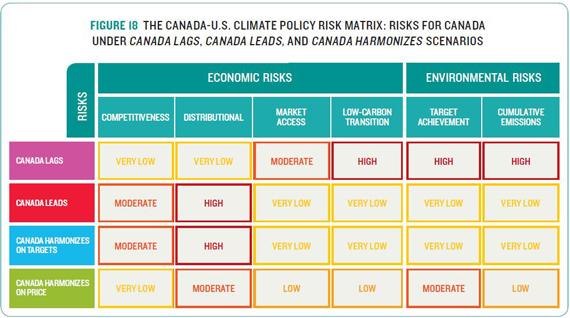Parallel Paths – 3.4 Summary: Lag, Lead, or Harmonize?
No scenario is risk free for Canada.
The figure below summarizes our combined analysis of risks for all four scenarios.37 As illustrated in Figure 18, different risks, both environmental and economic, are present across these four scenarios and trade-offs will be required.

Figure 18: The Canada-U.S. Climate Policy Risk Matrix: Risks for Canada Under Canada Lags, Canada Leads, and Canada Harmonizes Scenarios
Overall our analysis suggests that lagging behind the U.S. in implementing climate policy offers the most risks for Canada. Lagging the U.S. leads to both economic risks — from U.S. border adjustments and low-carbon fuel standards — and environmental risks, as Canada achieves no emission reductions and fails to stimulate low-carbon technological innovation. Further, we have shown that much of the economic impact on the Canadian economy in our forecast is a function of the stringency of Canadian policy and degree of restructuring in the Canadian economy that will result. That is, the analysis suggests that seeking to harmonize perfectly with the U.S. will reduce some competitiveness impacts, but will not eliminate the economic impacts of Canada’s eventual emission reductions. Indeed, delay risks making the ultimate achievement of emission-reductions more expensive; it delays the development and adoption of low-carbon technologies, encourages the continued investment in carbon-intensive technologies, and thus increases the overall and relative costs of achieving emission-reduction targets.
Implementing policy independent of the U.S., or leading, can ensure that Canada moves toward achieving its emissions reduction targets. Putting a carbon pricing policy in place now sends a signal to the economy to invest in low-carbon technologies. Beginning this transition earlier rather than later reduces the costs of achieving reductions both in the short and long terms. But implementing effective climate policy independent of the U.S. leads to economic competitiveness risks for some sectors.
Harmonization also poses risks. Our analysis suggests that harmonizing with the U.S. on targets will result in potentially higher carbon prices in Canada than in the U.S. and consequently in competitiveness risks for some Canadian sectors. Harmonizing on price would reduce — though not eliminate — economic risks. But it would also reduce the emission reductions Canada would achieve. And harmonization as an overall policy strategy also poses risks of delay, as long as U.S. legislation is in flux. Any policy that is entirely contingent on U.S. action will limit our progress toward reducing emissions domestically.
Canadian policy design choices offer opportunities to manage the risks apparent from these scenarios. The NRTEE’s approach has sought to achieve the most emission reductions at the least economic cost. We consider environmental and economic objectives jointly. Managing the inevitable environmental/economy trade-off leads us to consider where, when, and how Canada can harmonize climate policy with that of the United States to reduce competitiveness impacts, and where Canada can effectively lead the United States so it can begin to achieve its GHG emission reductions. The next chapter explores opportunities to do so.
[37] See Appendix 7.2 for a breakdown of our two-step approach to qualitatively assessing magnitude and likelihood of impacts.
























